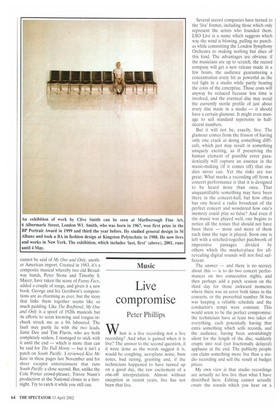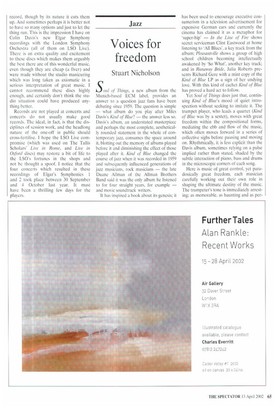Music
Live compromise
Peter Phillips
When is a live recording not a live recording? And what is gained when it is live? The answer to the second question, if it were done as the words suggest it is, would be coughing, aeroplane noise, bum notes, bad tuning, grunting and, if the technicians happened to have turned up on a good day, the raw excitement of a one-off interpretation. Almost without exception in recent years, live has not been that live.
Several record companies have turned to the 'live' format, including those which only represent the artists who founded them. LSO Live is a name which suggests which way the wind is blowing, pulling no punches while committing the London Symphony Orchestra to making nothing but discs of this kind. The advantages are obvious: if the musicians are up to scratch, the record company will get a new release made in a few hours, the audience guaranteeing a concentration every bit as powerful as the red light in a studio while partly bearing the costs of the enterprise. Those costs will anyway be reduced because less time is involved, and the eventual disc may avoid the currently sterile profile of just about every disc made in a studio — it should have a certain glamour. It might even manage to sell standard repertoire in halfdecent numbers.
But it will not be, exactly, live. The glamour comes from the frisson of having only one crack at doing something difficult, which just may result in something uniquely exciting, as if preserving the human element of possible error paradoxically will capture an essence in the music-making (if it comes off) that studios never can. Yet the risks are too great. What marks a recording off from a concert performance is that it is designed to be heard more than once. That unquantifiable something may have been there in the concert-hall, but how often has one heard a radio broadcast of the perfect concert and wondered how one's memory could play so false? And even if the music was played well, one begins to notice all the noises that should not have been there — more and more of them each time the tape is played. Soon one is left with a stitched-together patchwork of impressive passages divided by others which the market-place for allrevealing digital sounds will not find sufficient.
The answer — and there is no secrecy about this — is to do two concert performances on two consecutive nights, and then perhaps add a patch session on the third day for those awkward moments where there was an error both times in the concerts, or the proverbial number 38 bus was keeping a reliable schedule and the conductor's tempi were constant. This would seem to be the perfect compromise: the technicians have at least two takes of everything, each potentially having that extra something which sells records, and the audience, having been astonishingly silent for the length of the disc, suddenly erupts into real (yet fractionally delayed) applause at the end. The publicity people can claim something more live than a studio recording and sell the result at budget prices.
My own view is that studio recordings are actually no less live than what I have described here. Editing cannot actually create the sounds which you hear on a
record, though by its nature it cuts them up. And sometimes perhaps it is better not to have so many options and just to let the thing run, This is the impression I have on Colin Davis's new Elgar Symphony recordings with the London Symphony Orchestra (all of them on LSO Live). There is an extra quality and excitement to these discs which makes them arguably the best there are of this wonderful music, even though they are cheap (a fiver) and were made without the studio manicuring which was long taken as axiomatic in a serious interpretation of great music. I cannot recommend these discs highly enough, and certainly don't think the studio situation could have produced anything better.
Records are not played at concerts and concerts do not usually make good records. The ideal, in fact, is that the disciplines of session work, and the headlong nature of the one-off in public should cross-fertilise. I hope the LSO Live compromise (which was used on The Talks Scholars' Live in Rome, and Live in Oxford discs) may restore a bit of life to the LSO's fortunes in the shops and not be thought a spoof. I notice that the four concerts which resulted in these recordings of Elgar's Symphonies 1 and 2 took place between 30 September and 4 October last year. It must have been a thrilling few days for the players.



















































































 Previous page
Previous page